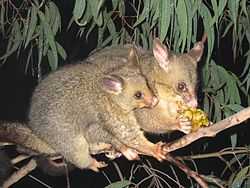Phalangeridae
| Phalangeridae[1] | |
|---|---|
 | |
| Common brushtail possum | |
| Scientific classification | |
| Kingdom: | Animalia |
| Phylum: | Chordata |
| Class: | Mammalia |
| Infraclass: | Marsupialia |
| Order: | Diprotodontia |
| Superfamily: | Phalangeroidea |
| Family: | Phalangeridae |
| Genus | |
| |
The Phalangeridae are a family of nocturnal marsupials native to Australia and New Guinea, including the cuscuses, brushtail possums, and their close relatives. Considered a type of possum, most species are arboreal, and they inhabit a wide range of forest habitats from alpine woodland to eucalypt forest and tropical jungle.
Characteristics
Phalangerids are relatively large, compared with other possums. The smallest species, the Sulawesi bear cuscus, is cat-sized, averaging 34 cm (13 in) in length, while the largest, the black-spotted cuscus is around 70 cm (28 in) long, and weighs 5 kg (11 lb). Besides the large size, other key features distinguishing phalangerids from other possums include the presence of bare skin on at least part of the tail, and low-crowned molar teeth. They have claws on the fore feet, but none on the hind feet, although these do have an opposable first toe to help grip onto branches. Additionally, in all but one species, both the first and second digits of the fore feet are opposable. The fur is typically dense or woolly, and may be grey, black, or reddish-brown, often with spots or stripes.[2]
Most phalangerids are folivores, feeding primarily on leaves. Like some similar species, they have a large cecum to ferment this highly fibrous food and extract as much nutrition as possible. However, their teeth are not as highly adapted to this diet as in other possums, and they also eat fruit, and even some invertebrates. The only exception to these general rules is the ground cuscus, which is carnivorous, and is also less arboreal than other phalangerid species.[2] The dental formula of phalangerids is:
| Dentition |
|---|
| 3.1.1.4 |
| 2.0.1-2.4 |
Gestation in phalangerids lasts 16–17 days in those species so far studied. The females have a well-developed pouch, and typically raise only one or two young at a time, less than many other possums. The adults are typically solitary, defending territories marked by scent-gland spray, odiferous saliva, urine, or dung.[2]
Classification
This classification is based on Ruedas & Morales 2005. The Phalangeridae family consists of six genera and 28 species.[1]
- Subfamily Ailuropinae
- Genus Ailurops
- Talaud bear cuscus (Ailurops melanotis)
- Sulawesi bear cuscus (Ailurops ursinus)
- Genus Strigocuscus
- Sulawesi dwarf cuscus (Strigocuscus celebensis)
- Banggai cuscus (Strigocuscus pelegensis)
- Genus Ailurops
- Subfamily Phalangerinae
- Tribe Phalangerini
- Genus Phalanger
- Gebe cuscus (Phalanger alexandrae)
- Mountain cuscus (Phalanger carmelitae)
- Ground cuscus (Phalanger gymnotis)
- Eastern common cuscus (Phalanger intercastellanus)
- Woodlark cuscus (Phalanger lullulae)
- Blue-eyed cuscus (Phalanger matabiru)
- Telefomin cuscus (Phalanger matanim)
- Southern common cuscus (Phalanger mimicus)
- Northern common cuscus (Phalanger orientalis)
- Ornate cuscus (Phalanger ornatus)
- Rothschild's cuscus (Phalanger rothschildi)
- Silky cuscus (Phalanger sericeus)
- Stein's cuscus (Phalanger vestitus)
- Genus Spilocuscus
- Admiralty Island cuscus (Spilocuscus kraemeri)
- Common spotted cuscus (Spilocuscus maculatus)
- Waigeou cuscus (Spilocuscus papuensis)
- Black-spotted cuscus (Spilocuscus rufoniger)
- Blue-eyed spotted cuscus (Spilocuscus wilsoni)
- Genus Phalanger
- Tribe Trichosurini
- Genus Trichosurus
- Northern brushtail possum (Trichosurus arnhemensis)
- Short-eared possum (Trichosurus caninus)
- Mountain brushtail possum (Trichosurus cunninghami)
- Coppery brushtail possum (Trichosurus johnstonii)
- Common brushtail possum (Trichosurus vulpecula)
- Genus Wyulda
- Scaly-tailed possum (Wyulda squamicaudata)
- Genus Trichosurus
- Tribe Phalangerini
References
| Wikimedia Commons has media related to Phalangeridae. |
- ↑ 1.0 1.1 Groves, C. P. (2005). Wilson, D. E.; Reeder, D. M, eds. Mammal Species of the World (3rd ed.). Baltimore: Johns Hopkins University Press. pp. 45–50. OCLC 62265494. ISBN 0-801-88221-4.
- ↑ 2.0 2.1 2.2 Dickman, Christopher R. (1984). Macdonald, D., ed. The Encyclopedia of Mammals. New York: Facts on File. pp. 850–855. ISBN 0-87196-871-1.
- Ruedas, L.A. & Morales, J.C. 2005. Evolutionary relationships among genera of Phalangeridae (Metatheria: Diprotodontia) inferred from mitochondrial data. Journal of Mammalogy 86(2):353-365.